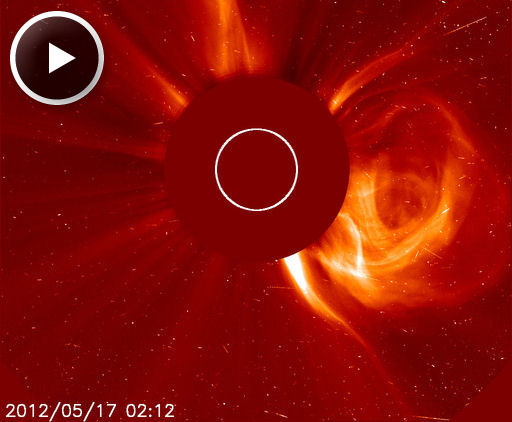INCOMING CME? A coronal mass ejection (CME) that flew off the sun's western limb on May 17th might hit Earth after all. NOAA forecasters say a shock wave from the blast could deliver a glancing blow to Earth's magnetic field on May 18th or 19th. The CME, pictured below, was propelled by an M5-class solar flare from departing sunspot AR1476.
The speckles in the movie are caused by energetic protons hitting the observatory's detector. Those protons may have been accelerated in part by the shock wave en route to Earth.
According to NOAA, there is a 40% chance of minor geomagnetic storms and a 15% chance of strong storms when the shock arrives. High-latitude sky watchers should be alert for auroras. CME alerts: text, phone.

![]()
Solar wind
speed: 417.5 km/sec
density: 5.9 protons/cm3
explanation | more data
Updated: Today at 1714 UT
![]()
X-ray Solar Flares
6-hr max: C2 1347 UT May18
24-hr: C3 0823 UT May18
explanation | more data
Updated: Today at: 1700 UT
![]()
![]()
![]()
Daily Sun: 18 May 12
![]()
![]()
A new sunspot is emerging at the circled location. Credit: SDO/HMI
![]()
![]()
![]()
Sunspot number: 114
What is the sunspot number?
Updated 17 May 2012
Spotless Days
Current Stretch: 0 days
2012 total: 0 days (0%)
2011 total: 2 days (<1%)
2010 total: 51 days (14%)
2009 total: 260 days (71%)
Since 2004: 821 days
Typical Solar Min: 486 days
Updated 17 May 2012
The Radio Sun
10.7 cm flux: 136 sfu
explanation | more data
Updated 17 May 2012
![]()
![]()
![]()
Current Auroral Oval:
![]()
Switch to: Europe, USA, New Zealand, Antarctica
Credit: NOAA/POES
![]()
![]()
![]()
Planetary K-index
Now: Kp= 2 quiet
24-hr max: Kp= 3 quiet
explanation | more data
![]()
Interplanetary Mag. Field
Btotal: 4.5 nT
Bz: 4.1 nT south
explanation | more data
Updated: Today at 1716 UT
![]()
![]()
![]()
Coronal Holes: 18 May 12
![]()
![]()
There are no large coronal holes on the Earthside of the sun. Credit: SDO/AIA.





